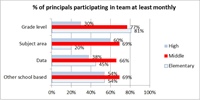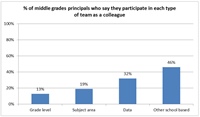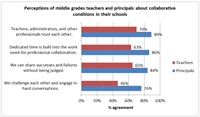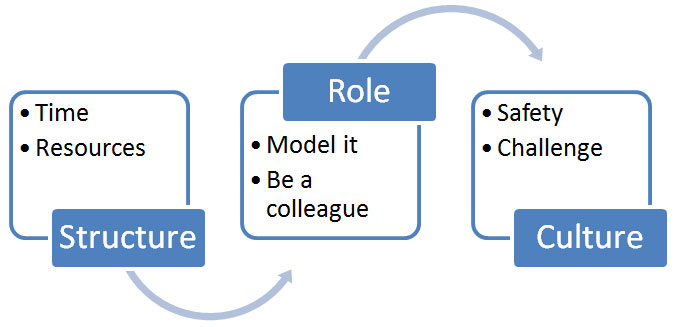Principals at all levels know—and research supports—that fostering effective collaboration among their staff is one of the most powerful things they can do to elevate the level of learning for adults and students. But as administrators, supporting and participating in collaboration can be tricky. Finding the time and other resources for educators to engage in deep conversations around teaching and learning is only the beginning. Beyond those structural issues of budgets and schedules lie even more challenging cultural questions. The graphic below summarizes some of the most important things that principals can do to foster effective collaboration in their schools.
Fortunately, experience with teaming has given middle grades principals some important advantages when it comes to building collaborative culture. Recent research from the National Center for Literacy Education (NCLE) reveals that middle grades principals are the most active of principals at all levels in participating in collaborative teams. Forty percent of middle grades principals report spending three or more hours per week working with teams, compared to 27% of both elementary and high school principals.
Take any kind of team and middle grades principals are active participants:

The flip side of all this team activity among middle grades principals, however, is that their time with teams is spread thin over many different groups. Middle grades principals reported participating in an average of 4.5 different teams at least monthly, compared to 3.4 for elementary and 3.3 for high school principals.
Middle grades principals try to be a presence in a variety of teams, but report that they mostly end up playing a supervisory role, not contributing to collaboration as a colleague.

For middle grades leaders trying to build a culture of collaboration, these data raise interesting questions about leadership roles. How can principals play more of a collegial role, honoring teacher-driven dialogue and supporting the development of trust that is necessary for challenging conversations to happen, while also maintaining some accountability that the collaboration stays focused on the school’s teaching and learning goals?
These are some of the important balancing acts for principals to consider:
| SUPERVISOR Being present in many teams Focusing on school goals Accountability Challenge |
VS. |
COLLEAGUE Engaging substantively in the work Teacher autonomy Safety Trust |
Certain conditions show up in the literature over and over again as fostering collaboration that makes a difference for teaching and learning: for example levels of trust among teachers and administrators and the extent to which teachers are comfortable making their practice public.
In the national survey, we asked respondents to what extent those conditions for effective collaboration exist in their schools. We found a clear pattern: principals are much more optimistic about the conditions for collaboration. Interestingly, although this perception gap between teachers and principals existed at all levels, it was largest in the middle grades, where principals tended to answer like elementary principals (who are most optimistic about collaboration) and teachers answered like high school teachers (who are least optimistic about collaboration).

If principals are going to build truly collaborative cultures, a conversation about how staff in your school perceive the conditions for collaboration might be a good way to start. For example, consider questions like these:
What does a ‘hard conversation’ about teaching and learning look like?
When have we had those conversations in our school and when have we avoided them?
When has a conversation with colleagues had an impact on your practice?
Based on the research on conditions for effective collaboration, NCLE has developed a quick, free survey tool schools can use to open up such a dialogue.
With the coming of the Common Core State Standards, giving teacher teams the time and space to engage in deep, shared learning is more critical for middle grades leaders than ever. Our data suggest that to foster the most productive collaboration, middle grades principals should take a hard look at the supporting conditions in their building, including their own role as both supervisor and colleague. What experiences or insights do you have about how principals can pull off this tricky balance?
Don’t forget to complete the NCLE professional learning questionnaire sent by e-mail to AMLE members on October 7. This survey will identify recommendations for collaborative learning and literacy standards for our profession.
Catherine Nelson, Ph.D., is an evaluation and research consultant for the National Center for Literacy Education.
This article appeared in AMLE Newsletter, October 2013.
